By Bill Adams
What are commonly referred to as coffin compartments on pumpers and rescues are located above their exterior high-side compartments. They are usually equipped with hinged lift-up doors accessible from the hosebed on pumpers and via open center aisles (walkways) on walk-around rescue trucks.
Some have vertically hinged access doors usually around 12 × 12 inches at the rear of the apparatus. Coffin compartments can be an ideal location to store seldom used equipment; however, it can be inherently dangerous for firefighters to access or replace the equipment in them.
Merriam-Webster’s Dictionary defines a coffin as “a box or chest for burying a corpse.” Coffin compartments may be an inappropriate term for buyers and sellers to use when describing them in purchasing specifications. It is especially so if a firefighter is grievously injured when accessing equipment from one. Visualize an attorney specializing in personal injury litigation questioning a buyer or seller in court under oath: “Did you write the specifications that defined the coffin compartment? Was your expectation that a firefighter might end up in a coffin when accessing equipment from the compartment?”
Several fire apparatus manufacturers were asked to answer some generic questions about coffin compartments. Responding were Wyatt Compton, product manager for Spartan Emergency Response (Spartan ER); Joel Konecky, vice president of sales for SVI Trucks; Dave McAlice, eastern regional vice president for Pierce Manufacturing; Ed Boring, fleet sales manager for HME-Ahrens Fox (HME-AF); and Mike Watts, national sales manager for Toyne, Incorporated.
QUESTIONS AND RESPONSES

1 This SVI rescue-pumper has two coffin compartments on each side of the hosebed with grab handles to open and “Not A Step” warning labels on each cover. There’s a pull-out/drop-down angled access ladder to an upper recessed stepping area. Access to the compartments from above requires kneeling on the aluminum treadplate hosebed covers when they’re in the closed position. There are different sized rear vertical hinged access doors to the compartments. The grab handles are below the height of the shroud protecting the cab-mounted light tower when in the stowed position. (Photos 1 and 2 courtesy of SVI Trucks.)
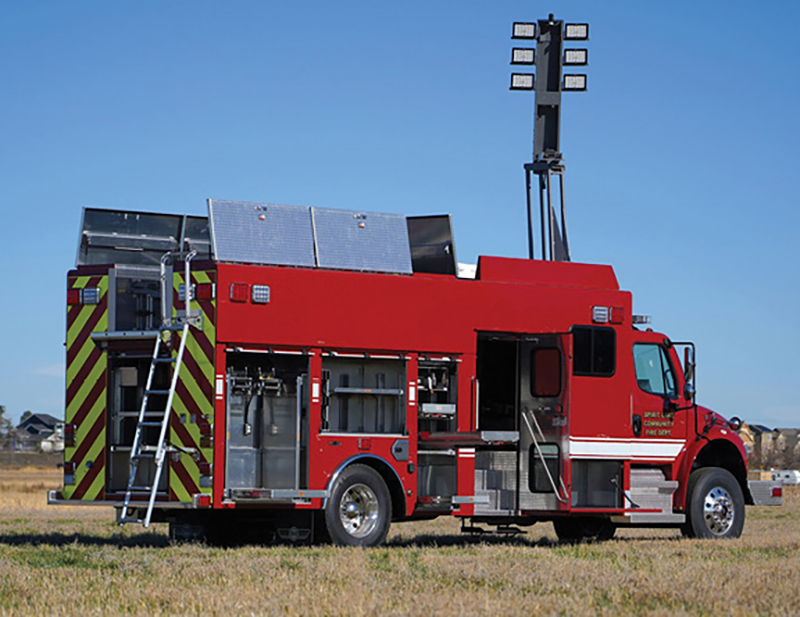
2 Five coffin compartments with reinforced hat sections and warning labels on the covers are on this SVI walk-around rescue truck with a center walkway. The offset out-and-down angled ladder provides full access to the rear center compartment below the walkway.
Have coffin compartments become a popular option on pumpers and rescue-pumpers?
Watts: They are a common option.
Boring: Coffin compartments continue to be popular at HME-AF as departments continue to multipurpose their fire apparatus. Coffin compartments oftentimes provide bonus space that doesn’t add to the overall length and height of their rigs.
McAlice: At Pierce Manufacturing, we are seeing many rescue-pumpers being designed with these upper compartments for additional storage. Larger equipment can be stored away nicely, leaving the lower compartments open for more frequently used rescue tools and firefighting equipment. When electric cord, air hose, or hydraulic hose reels are included, this upper area can nicely house each reel—with the cords or hoses routed down into each assigned compartment, using captive rollers for easier deployment when needed.
Konecky: With departments running more EMS or special service calls, we have seen an increase in customers buying engines who are trying to increase storage without increasing the overall length of the apparatus.
Compton: Upper storage compartments have had varying degrees of popularity for well over 20 years here. While they’re nearly standard on all rescues and rear-mount pumpers, the rescue-pumper and compact pumpers have seen much usage.
Have coffin compartments located above high-side equipment compartments become a popular option on walk-around rescue trucks?
Konecky: I would estimate that upper body compartments are specified on over 90% of the walk-around rescues that SVI builds. This is a very popular option.
Watts: Yes.
McAlice: Like rescue-pumper bodies, the average walk-around (nonwalk-in) heavy rescue bodies frequently are designed with a staircase or rear ladder to access the upper body area. These coffin compartments have gained popularity for similar larger hand tools and equipment.
Compton: A structure above the side exterior compartments makes for a good amount of storage volume, so it’s nearly standard on any walk-around rescue at Spartan ER. Design-wise, scene lighting is most effective when the light is mounted as far outboard as possible above the highest side storage compartment.
Boring: Yes, definitely. Again, they provide bonus space without making the rig bigger. Coffin compartments are a great place to store lesser used equipment.
Does your company have another moniker for coffin compartments?
McAlice: “Hatch compartments” is a more proper term (think U.S. Navy)! But, we know both the industry and fire service have a lot of slang names for many apparatus items.
Compton: Typically, Spartan ER refers to them as “upper storage compartments,” which seems to be well understood.
Watts: No, we call them coffins.
Boring: In the wildland environment, they are sometimes referred to as “Out of County” storage because they sometimes store deployment bags in them.
Konecky: Upper body compartments.
If your company has common sizes or configurations of coffin compartments, what are they?
Konecky: Depending on the length of the body, we typically have one compartment at the front of the body that runs full width (side-to-side) that is 90.0 inches long by 27.0 inches wide by 28.5 inches deep. Then, we have two to three compartments on each side of the body, running the length of the body, that are 60 to 90 inches long by 28.0 inches wide by 28.5 inches deep. Depth can vary based on the overall height requirements of the department.
Compton: Unless there’s a special item to work around, the compartments will typically run the length of the body, and side-to-side width matches the depth of the compartments below (i.e., half depth or full depth).
McAlice: The key is to use all available upper body space available. In many cases, the body lengths vary between pumpers and heavy rescues. We maximize these dimensions on each body offering.
Watts: Size is dependent on the lower body layout.
Boring: HME-AF has no single standard; however, generally they are as wide as the side exterior compartments by the length of the body. Depth is determined by hosebed height.
Are coffin compartments usually bolted on, or are they integrally welded as part of the body?
McAlice: At Pierce, they are currently an integral part of the welded body structure.
Compton: Spartan ER’s upper compartments are built integrated to the body. Our bodies use hollow structural members, and this makes wire access extremely simple since it makes for a secure conduit connecting the lower to upper compartments.
Konecky: SVI designs the upper body compartments to be integral to the body design.
Boring: Nowadays, they are integrated into the body design. They could be bolt-ons in some cases.
Watts: Toyne builds mostly bolted bodies. The coffins are designed as an integral part of the body and not an add on. Our welded bodies would be the same.
What is the most common material used for coffin compartments?
Boring: The body material is the most common material. If they are bolt-on, I would say aluminum diamond plate is the go-to material.
Konecky: Since our upper body compartments are integral to the body, we use the same material as used in the body construction—3003H-14 alloy smooth plate aluminum.
McAlice: Pierce apparatus bodies can be built using either high-strength aluminum or stainless steel. In each case, the upper compartments would match that material used. Interiors are aluminum and offer either smooth plate or diamond plate material.
Watts: Toyne is a stainless steel builder.
Compton: Since the compartments are integral to the body, the material matches that of the body—either aluminum or stainless steel. The rigid structural members that are used in the body also extend up into the upper storage compartments, providing the body with further reinforcement.
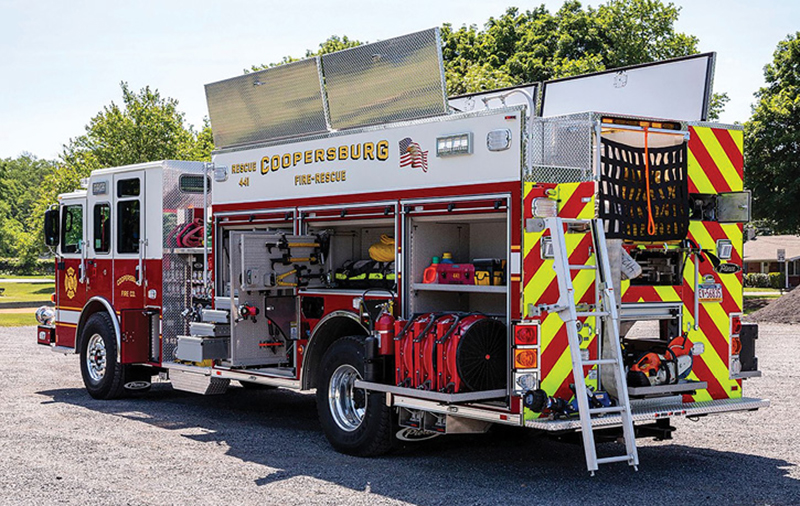
3 This Pierce rescue-pumper’s four coffin compartments are above full-depth full-height exterior side compartments. Two are on each side of the hosebed. Their covers appear to have full inner box pans. There’s an out-and-down angled access ladder and recessed upper stepping area. Access to the compartments is from the open hosebed. The small vertical hinged doors on the rear access long storage behind the side compartments’ shutter door rolls. (Photos 3 and 4 courtesy of Pierce Manufacturing.)
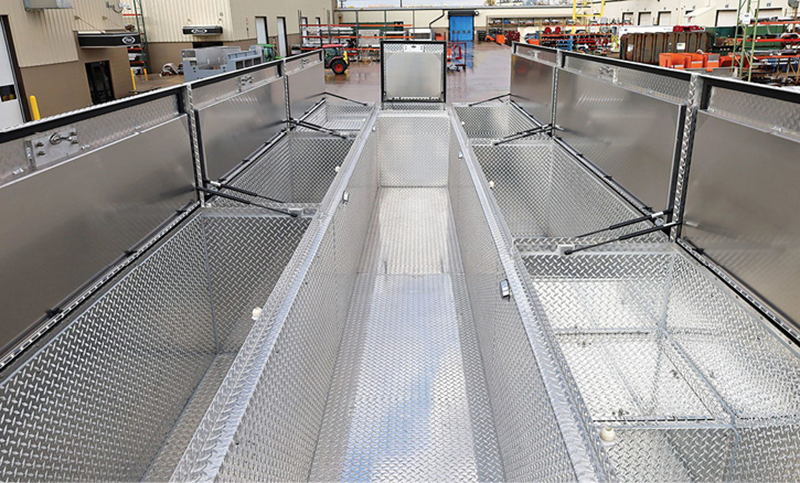
4 This Pierce walk-around rescue truck has coffin compartments on each side and at the end of the center walkway. The doors have large hat-section reinforcements, dual hold-open pistons, and LED strip lighting on the hinge side of the covers. Note the “snap-to-hold” door closures. Removable covers in two compartments are probably to access cord reels.
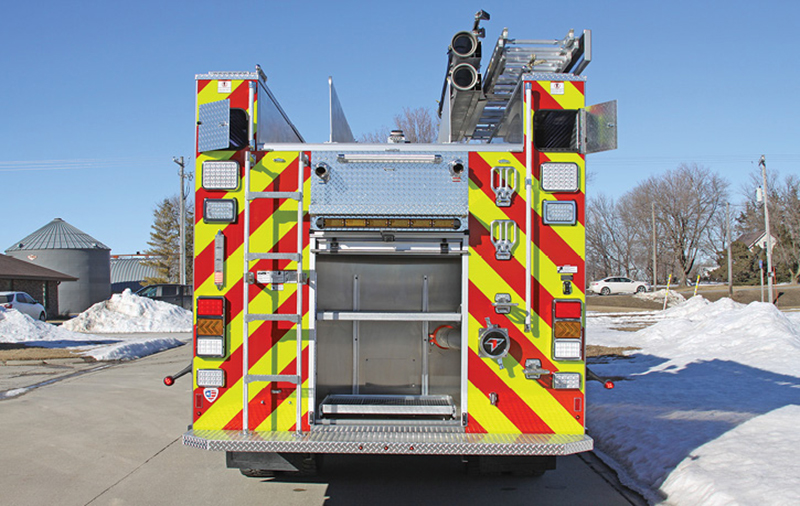
5 This Toyne pumper has coffin compartments above the half-depth high-side exterior compartments. Both have small vertical hinged rear access doors. The tops of their lift-up covers are just visible above the rear panel. (Photos 5 and 6 courtesy of Toyne, Inc.)
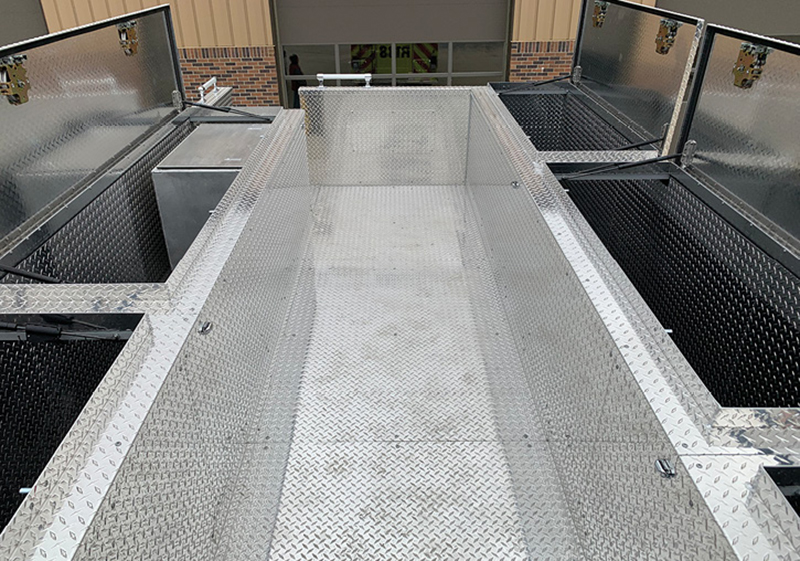
6 The center walkway aisle on this Toyne walk-around rescue truck shows lift-up coffin compartment doors with dual twist-to-open recessed latches, dual hold-open pistons, and small hooded lights in the walkway aisle. It also features a standing area offset at the rear.
What is the most common material used to construct the compartments’ lift-up doors?
McAlice: Typically, an aluminum treadplate double pan door with lifting and hold-open pistons.
Boring: In almost every case, I would say aluminum treadplate.
Compton: Most Spartan ER customers opt for embossed (nonskid) treadplate doors, which is perfect for any horizontal surface that can be stepped on.
Watts: Aluminum diamond plate.
Konecky: 3⁄16-inch aluminum tread plate.
Are coffin compartments ever specified with interior lights?
Boring: Yes, they typically have LED strip lights or round lights recessed into the inner door pan.
Konecky: Yes, [the National Fire Protection Association (NFPA)] requires compartment lights to be installed in areas that have 4 cubic feet or more of storage.
Watts: All coffin compartments from Toyne come standard with strip lighting.
Compton: Upper storage compartment lighting will always be specified. Typically, it will be the same lighting specified in the lower compartments, which will typically be light strips.
McAlice: We include compartment lighting for night use, typically either a series of 4-inch round lights, or more full-length LED bar lights can be used.
If coffin compartments are specified with drains, how should purchasers specify them?
Konecky: SVI provides drains as standard in all upper body compartments. Since fire departments operate in all-weather conditions, compartments on top of the body can catch a lot of precipitation when doors are left open on scene. The drains need to be much larger than those specified inside compartments. A minimum of 1-inch flexible drain tube that terminates below the body should be specified. In addition, if there is an upper walkway, 1-inch flexible drain tubes should also be specified, installed at the front of the upper walkway, and include grating to prevent leaves or other debris from clogging up the drain tubes. These drains should be inspected periodically, and debris should be removed so they work properly in inclement weather.
In addition, if customers are in extremely humid areas or areas of high precipitation, we recommend adding a forced-air compartment ventilation system that will provide additional airflow once back at the station to aid in drying out the compartment and equipment stored in the compartment. SVI offers a forced-air ventilation system. The fan runs for a preset time and turns on and off automatically when the apparatus is plugged into the shoreline.
Watts: Yes. The drains need to drain to the ground under the truck.
McAlice: Yes. Pierce typically includes corner drain holes with short spouts under each floor connected to [polypropylene] hoselines. These would each be routed down between the lower compartments so they can drain to ground. This is helpful during long duration events in the event of heavy rain or deck-gun spray vs. needing to hand dry each storage bin afterward.
Compton: Drainage is standard. Drains run from the corners of the upper compartments down to below the apparatus. This gives not only a drain but ventilation that is independent of the lower compartments. As with any compartment that has upward access that can be left open to the elements, drains should be installed in the corners. This allows water to move and drain regardless of the surface the apparatus is parked on, plus aids in cleanliness since compartments tend to gather dirt and moisture in the corners.
Boring: The compartments should be watertight, so they typically do not. But, they certainly could be specified with drains, presuming they want the drain primarily for a clean out. I would suggest verbiage like: “Compartments shall include a drain to atmosphere. Drain shall be sufficiently sized to allow for the washing out of debris. In no case shall the drain terminate in any other compartment.”


7, 8 The interior of two coffin compartments on a Spartan ER walk-in rescue. The aisleway has recessed walkway lighting and the compartment’s LED strip lighting is semirecessed below the covers’ hinged sides. One features a front-to-rear adjustable partition. Coffin compartments provide ideal storage for electric rewind air, hydraulic, and electric cord reels, freeing up exterior side compartmentation. Access panels in coffin compartments can provide access to equipment requiring servicing that may be mounted behind the door rolls on side exterior compartments. These doors feature hat sections and flush-mounted exterior latches. (Photos 7 and 8 courtesy of Spartan ER.)
Are most coffin compartments equipped with lift-up doors?
Watts: Yes.
McAlice: Yes, correct.
Compton: Yes, unless the equipment stored is more safely removed to the rear.
Boring: Yes, that’s about the only solution.
Konecky: Yes, this is the simplest and most effective way of protecting equipment stored in the compartment from the elements.
Is there a recommended size (length or weight) for a lift-up door?
Boring: As large as possible without infringing on the hosebed.
Watts: No. They are custom done based on the size of the compartment.
Compton: Unless equipment size dictates, a door length of around 60 inches tends to be the most ergonomic. The width and weight of the door are less of a factor because doors have hold-open devices that lift the doors. Almost more of a consideration is the total door area, as when it’s up above, all the equipment on the ground can catch a lot of wind!
McAlice: On typical rescue-pumpers, the door openings can measure 5 to 7 feet long. On longer heavy rescues, they can measure up to 9 feet long. In each case, we utilize weight-appropriate hydraulic lifting and hold-open pistons for safety. These also hold the closed doors in the down position.
Konecky: At SVI, we try to limit the length of an upper compartment door to no more than 90 inches long. We also install gas-charged assist struts to aid in opening the door as well as keeping the door open to allow access to equipment stored.
When equipped with rear-facing hinged doors, what equipment is commonly stored there?
Boring: Depends on the application.
McAlice: Depending on the compartment’s depth, we typically see water rescue equipment, rope rescue gear and rigging, sometimes Stokes and stretchers, and EMS backboards. On walk-around rescues, it’s not unusual to store various sized ladders.
Watts: Long tools, backboards (depending on compartment width), and suction hose.
Compton: Outstanding question—through the planning process, many long items that wouldn’t normally fit in the lower compartments are stored above the compartments with rear-facing doors. This could be pike poles, long handled tools, etc.
Part 2 will continue the interview with the fire apparatus manufacturers. It will address parts of NFPA 1900, Standard for Aircraft Rescue and Firefighting Vehicles, Automotive Fire Apparatus, Wildland Fire Apparatus, and Automotive Ambulances, applicable to coffin compartments and firefighters’ access to them. Purchasing specifications and the responsibilities of both purchaser and apparatus manufacturers will also be discussed.
BILL ADAMS is a member of the Fire Apparatus & Emergency Equipment Editorial Advisory Board, a former fire apparatus salesman, and a past chief of the East Rochester (NY) Fire Department. He has 50 years of experience in the volunteer fire service.

